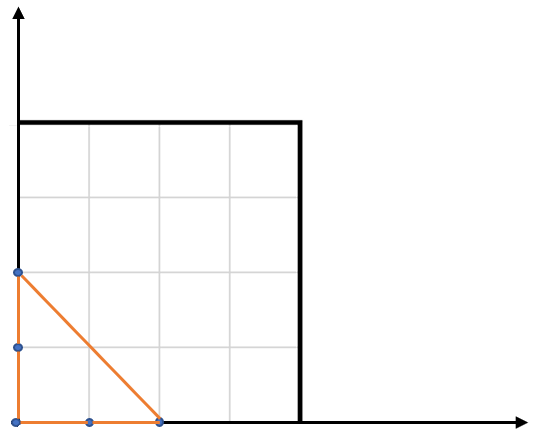- {x}
- Unique Morse Code Words
- Split Array With Same Average
- Number of Lines To Write String
- Max Increase to Keep City Skyline
- Soup Servings
- Expressive Words
- Chalkboard XOR Game
- Subdomain Visit Count
- Largest Triangle Area
- Largest Sum of Averages
- Binary Tree Pruning
- Bus Routes
- Ambiguous Coordinates
- Linked List Components
- Race Car
- Most Common Word
- Short Encoding of Words
- Read More...

Largest Triangle Area
Given an array of points on the X-Y plane points where points[i] = [xi, yi], return the area of the largest triangle that can be formed by any three different points. Answers within 10-5 of the actual answer will be accepted.
Example 1:

Input: points = [[0,0],[0,1],[1,0],[0,2],[2,0]] Output: 2.00000 Explanation: The five points are shown in the above figure. The red triangle is the largest.
Example 2:
Input: points = [[1,0],[0,0],[0,1]] Output: 0.50000
Constraints:
3 <= points.length <= 50-50 <= xi, yi <= 50- All the given points are unique.
Solution Explanation for Largest Triangle Area
The problem asks to find the largest area of a triangle that can be formed using any three points from a given set of points in a 2D plane.
Approach:
The most straightforward approach is to iterate through all possible combinations of three points, calculate the area of the triangle formed by each combination, and keep track of the maximum area encountered. The area of a triangle with vertices (x1, y1), (x2, y2), and (x3, y3) can be calculated using the determinant formula:
Area = 0.5 * |x1(y2 - y3) + x2(y3 - y1) + x3(y1 - y2)|
Alternatively, we can use the shoelace formula (or Gauss area formula) which is more computationally efficient. However, the difference in performance is minor given the problem constraints. The determinant formula is presented below because it's easier to understand intuitively.
Time Complexity Analysis:
The code iterates through all possible combinations of three points from the input array. The number of such combinations is given by the combination formula: nC3 = n! / (3! * (n-3)!), where n is the number of points. This simplifies to O(n³). All other operations within the loops (area calculation, comparison) take constant time. Therefore, the overall time complexity of the solution is **O(n³) **.
Space Complexity Analysis:
The algorithm uses only a constant amount of extra space to store variables for calculations and to track the maximum area. Therefore, the space complexity is O(1).
Code Explanation (Python):
class Solution:
def largestTriangleArea(self, points: List[List[int]]) -> float:
ans = 0
for i in range(len(points)):
for j in range(i + 1, len(points)):
for k in range(j + 1, len(points)):
x1, y1 = points[i]
x2, y2 = points[j]
x3, y3 = points[k]
area = 0.5 * abs(x1 * (y2 - y3) + x2 * (y3 - y1) + x3 * (y1 - y2))
ans = max(ans, area)
return ans
The code iterates through all unique combinations of three points using nested loops. For each combination, it calculates the area using the determinant formula and updates the ans variable if a larger area is found. The abs() function ensures a positive area.
Code in Other Languages (Java, C++, Go):
The provided Java, C++, and Go codes implement the same algorithm, iterating through all combinations of three points and calculating the area using the determinant formula. The core logic remains identical, only the syntax and specific library functions differ. Time and space complexity remain O(n³) and O(1) respectively for all implementations.